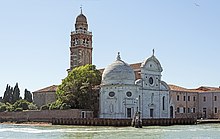San Michele in Isola
San Michele in Isola , including San Michele di Murano is a church and a former Camaldolese monastery on the cemetery island of San Michele in the lagoon of Venice between the district Castello , to whom the island is today, and Murano .
history
At the site of today's church, on the still uninhabited island, St. Romuald is said to have lived as a hermit in the 970s . The earliest previous building, the foundation of a wealthy patrician family, is dated to the end of the 10th century. In 1212 the island was given to the Camaldolese order, who built a new church and convent building there by 1221. These were extensively restored around 1300, but were dilapidated again after the middle of the 15th century and were demolished. The campanile was rebuilt in 1460 in Gothic form.
Construction of the rest of the building complex began in 1469. The design was created by the important master builder Mauro Codussi . It was his first commission in Venice and the city's first Renaissance church .
In 1530, next to the portal facade, on the northern tip of the island, the Cappella Emiliani was built as a mausoleum for the wealthy widow Margarita Vitturi Emiliani , a work by Guglielmo Bergamasco (1485 - 1556).
The monastery experienced times of religious and cultural prosperity. In 1434 a religious college for theology, philosophy and ancient languages and literature was attached to it. At the time of its dissolution in 1810, the monastery library was one of the most important in the region with 40,000 volumes, including valuable manuscripts and incunabula . The monk and cartographer Fra Mauro († 1459) drew his world map here, one of the most important testimonies to the pre-Columbian worldview. Other monks and teachers of the monastery were Niccolò Malermi , Bernardino Gadolo (1463-1499), Angelo Calogerà (1699-1764), Giambenedetto Mittarelli (1707-1777) and Placido Zurla . In the 1780s, the future Pope Gregory XVI. Conventual in San Michele.
After Napoleon's conquest of the Republic of Venice in 1797, the Camaldolese monastery was closed in 1810 and the island became state property. Then began its extensive conversion into the new municipal cemetery, for which it was connected to the immediately neighboring island of San Cristoforo by filling in 1837. The monastery church of San Michele with cloister and the Cappella Emiliani have been preserved.
Architecture and equipment
church
San Michele is an outwardly simple three-aisled basilica . The naves are separated on the inside by slim columns and wide arches and have coffered ceilings . All three lead into a choir with a round apse . A flat dome with a round drum stands above the main choir . It is separated inside with two choir arches, giving the impression of a square crossing . A spacious, richly decorated gallery is built into the west yokes of the nave .
The portal facade, which faces west towards the lagoon, reveals a will to represent, a characteristic, at the time new design by Codussi. It consists of white Istrian karst marble and reflects the three-nave structure of the church. The middle section is crowned by a semicircular arch, the lower sides close with quarter circles. Beams and pilasters , a central round window and two slim round arched windows structure the area.
The church used to house important works of art, but the most important of these were sold after the monastery was closed. Noteworthy is a sculpture of Jerome by Giusto Le Court (1627 - 1679).
Campanile
The bell tower from 1460 made of exposed brickwork is the only Gothic part of the ensemble. It rises free-standing next to the north aisle on a square floor plan. Horizontal decorative friezes divide it into floors. An octagonal upper floor with a spherical helmet forms the conclusion.
Cloister
The cloister, a slightly irregular square consisting of four rows of arcades with 57 round arches, in the middle of which is a fountain, offers an image of rare unity and tranquility.
Cappella Emiliana
The Cappella Emiliana, an exemplary Renaissance mausoleum, is a hexagonal, clearly proportioned central building with a dome made of Istrian stone over a short drum . The order for the construction of the Cappella was given to the architect Guglielmo de 'Grigi d'Alzano by the procurators of San Marco in 1528; the construction was completed in 1543 by Mauro Codussi. The construction was financed by a foundation from 1427 by Margherita Vitturi, the widow of Giovambattista Miani (Emiliani). Therefore the Cappella of St. Dedicated to Margareta .
Inside it is equipped with floors made of precious geometric and colored marble incrustations and with stone relief altarpieces .
Between 2000 and 2006, the building was scientifically examined and extensively restored as part of the UNESCO International Private Committees Program for the Safeguarding of Venice .
literature
- Thorsten Droste : S. Michele in Isola . In: Venice . DuMont Art Travel Guide, Cologne 4/1990, ISBN 3-7701-1654-2 , p. 370f.
- Erich Egg , Erich Hubala u. a. (Ed.): Upper Italy East. Reclam's Art Guide Italy, Vol. II. Stuttgart 1965, pp. 912–917.
- Alberto Lionello, Claudio Menichelli: The unusual dome of the Cappella Emiliana on the Island of San Michele in the Venice Lagoon. (PDF, 1.0 MB) UNESCO, 2011, accessed on March 16, 2015 (English, lecture at Domes in the World , Florence, March 20, 2012).
Web links
- San Michele (website of the parish, Italian)
- Convento di San Michele in Isola - Venezia (via the library, nuovabibliotecamanoscritta.it, Italian)
Coordinates: 45 ° 26 ′ 56.8 " N , 12 ° 20 ′ 49.1" E


